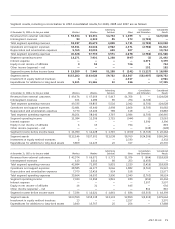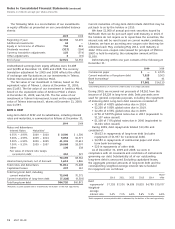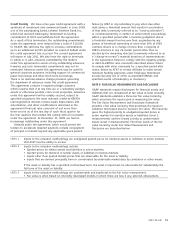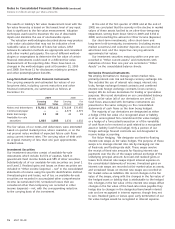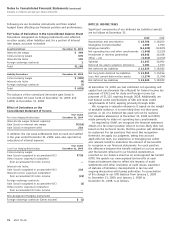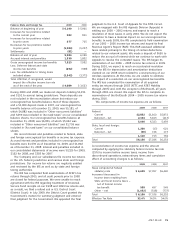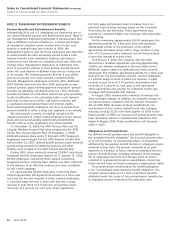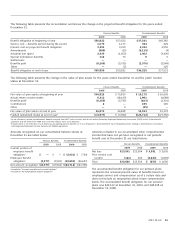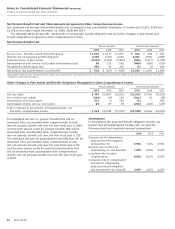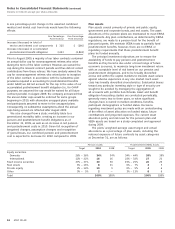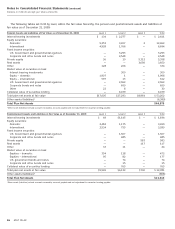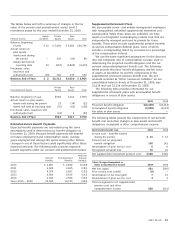AT&T Wireless 2009 Annual Report Download - page 82
Download and view the complete annual report
Please find page 82 of the 2009 AT&T Wireless annual report below. You can navigate through the pages in the report by either clicking on the pages listed below, or by using the keyword search tool below to find specific information within the annual report.
Notes to Consolidated Financial Statements (continued)
Dollars in millions except per share amounts
80 AT&T 09 AR
For both wage and pension band increases, there is a
potential cost-of-living increase based on the Consumer
Price Index for the third year. These agreements also
provide for continued health care coverage with reasonable
cost sharing.
For the remaining approximately 26,000 employees, the
agreement provides for a four-year term with provisions
substantially similar to the provisions of the ratified
agreements discussed above, with a wage increase in year
four of 2.75 percent and a potential cost-of-living increase
in year four instead of in year three.
On February 8, 2010, the Company and the CWA
announced a tentative agreement covering approximately
30,000 core wireline employees in the nine-state former
BellSouth region, subject to ratification by those covered
employees. The tentative agreement provides for a three-year
term and, for the vast majority of those covered employees,
a 3 percent wage increase in years one and two, a wage
increase in year three of 2.75 percent, and pension band
increases of 2 percent for each year of the agreement.
These agreements also provide for continued health care
coverage with reasonable cost sharing.
In August 2009, retirees were informed of medical and
drug coverage changes. In addition, we adopted changes to
our pension plans consistent with the Pension Protection
Act of 2006 (PPA). Because of these modifications, our
amortization of prior service (benefit) cost also changed,
reducing costs by $128 in the third quarter of 2009. In the
fourth quarter of 2009, our pension and postretirement costs
have decreased, which is consistent with reductions that
began in August 2009. These modifications will decrease
costs in 2010.
Obligations and Funded Status
For defined benefit pension plans, the benefit obligation is
the “projected benefit obligation,” the actuarial present value,
as of our December 31 measurement date, of all benefits
attributed by the pension benefit formula to employee service
rendered to that date. The amount of benefit to be paid
depends on a number of future events incorporated into the
pension benefit formula, including estimates of the average
life of employees/survivors and average years of service
rendered. It is measured based on assumptions concerning
future interest rates and future employee compensation levels.
For postretirement benefit plans, the benefit obligation
is the “accumulated postretirement benefit obligation,” the
actuarial present value as of a date of all future benefits
attributed under the terms of the postretirement benefit plan
to employee service rendered to the valuations date.
NOTE 11. PENSION AND POSTRETIREMENT BENEFITS
Pension Benefits and Postretirement Benefits
Substantially all of our U.S. employees are covered by one of
our noncontributory pension and death benefit plans. Many of
our management employees participate in pension plans that
have a traditional pension formula (i.e., a stated percentage
of employees’ adjusted career income) and a frozen cash
balance or defined lump sum formula. In 2005, the
management pension plan for those employees was amended
to freeze benefit accruals previously earned under a cash
balance formula. Each employee’s existing cash balance
continues to earn interest at a variable annual rate. After this
change, those management employees, at retirement, may
elect to receive the portion of their pension benefit derived
under the cash balance or defined lump sum as a lump sum
or an annuity. The remaining pension benefit, if any, will be
paid as an annuity if its value exceeds a stated monthly
amount. Management employees of former ATTC, BellSouth,
AT&T Mobility and new hires after 2006 participate in cash
balance pension plans. Nonmanagement employees’ pension
benefits are generally calculated using one of two formulas:
benefits are based on a flat dollar amount per year according
to job classification or are calculated under a cash balance
plan that is based on an initial cash balance amount and
a negotiated annual pension band and interest credits.
Most nonmanagement employees can elect to receive their
pension benefits in either a lump sum payment or an annuity.
We also provide a variety of medical, dental and life
insurance benefits to certain retired employees under various
plans and accrue actuarially determined postretirement
benefit costs as active employees earn these benefits.
On December 31, 2009, the AT&T Pension Plan and the
Cingular Wireless Pension Plan were merged into the AT&T
Puerto Rico Pension Benefit Plan. At November 1, 2008,
BellSouth pension plans and U.S. Domestic ATTC bargained
employees were merged into the AT&T Pension Benefit Plan.
At December 31, 2007, defined benefit pension plans formerly
sponsored by Ameritech Publishing Ventures and AT&T
Mobility were merged in the AT&T Pension Benefit Plan.
During 2009, union contracts covering 120,000 collectively
bargained wireline employees expired. As of January 31, 2010,
86,000 employees covered by these expired collectively
bargained wireline contracts have ratified new labor contracts.
In the absence of an effective contract, the union is entitled
to call a work stoppage.
For approximately 60,000 employees covered by these
ratified agreements, the agreements provide for a three-year
term and, for the vast majority of those covered employees,
a 3 percent wage increase in years one and two, a wage
increase in year three of 2.75 percent, and pension band
increases of 2 percent for each year of the agreement.



